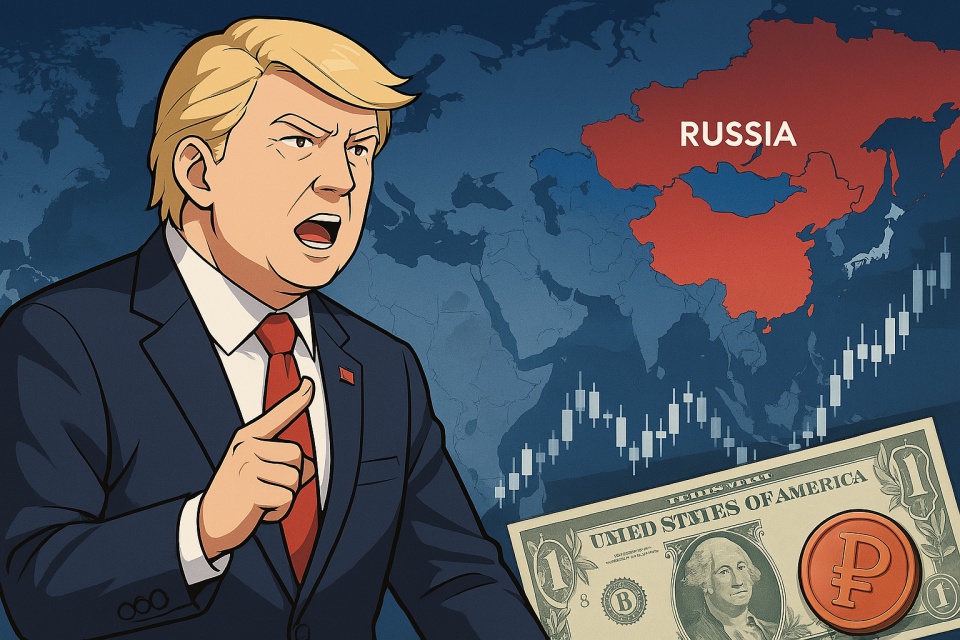Former President Donald Trump, now back in office, recently proposed easing U.S. sanctions on Russia in exchange for a Black Sea ceasefire. While no formal deal has been struck, this remark sparked immediate debate—both politically and in the markets. For FX traders, the implications stretch beyond geopolitics: a potential shift in U.S.-Russia relations could send ripple effects across the USD/JPY and commodity-linked currencies.
In this article, we analyze the market reactions, sentiment on X (formerly Twitter), and possible strategic outcomes for currency traders.
📌 Key Takeaways
- 📰 Trump’s Proposal: President Trump’s suggestion of a ceasefire-for-sanctions deal could reset U.S.-Russia relations and revive flows of sanctioned commodities.
- 📉 Market Sensitivity: The dollar dipped slightly as traders reassessed geopolitical risks and their FX implications.
- 💬 X Sentiment: Public response on X was overwhelmingly critical, suggesting a credibility gap in the market’s eyes.
- 💱 Currency Impact: USD/JPY and commodity FX pairs like AUD and NOK could respond strongly to signs of policy change.
- 🧠 Strategic Outlook: Traders should watch for signals of actual policy shifts—and prepare for volatility in dollar-crosses.
- 📣 Introduction – A Political Signal That Moved the Markets
- 🗺️ What Did Trump Say About the Black Sea and Russia?
- 📊 Market Interpretation – What’s at Stake for FX Traders?
- 💥 X (Twitter) Reactions – Trader Sentiment Turns Critical
- 💱 Currency Focus – Implications for USD/JPY and Commodity FX
- 🎯 Trade Setups – Strategic Scenarios Based on Outcomes
- 🧭 Conclusion – A Ceasefire That Could Shake the Dollar?
📣 Introduction – A Political Signal That Moved the Markets
On March 26, 2025, President Donald Trump suggested he was open to easing sanctions on Russia in exchange for a ceasefire agreement in the Black Sea region. The statement—brief but loaded with geopolitical implications—was enough to catch the attention of both political analysts and financial markets.
While no formal diplomatic agreement has followed, Trump’s remarks have raised new questions about the future of U.S.-Russia relations, particularly regarding trade, commodities, and sanctions policy. For foreign exchange (FX) traders, even rhetorical shifts from the White House can act as early signals of potential structural change.
The FX market, ever sensitive to geopolitical risk, responded modestly but noticeably. The U.S. dollar weakened slightly against major currencies following the news, reflecting uncertainty about the consistency and credibility of future U.S. foreign policy.
This section sets the stage for analyzing what exactly was said, how the market reacted, and what traders can expect going forward—from sentiment trends on X (formerly Twitter) to trade setups across dollar-related pairs.
🗺️ What Did Trump Say About the Black Sea and Russia?
During a recent press briefing, President Donald Trump confirmed he was open to easing sanctions on Russia in exchange for a ceasefire in the Black Sea region. While he offered few specifics and did not outline a formal diplomatic channel, the statement quickly drew attention?especially given ongoing tensions in the region.
The Black Sea has been a focal point of conflict since Russia’s full-scale invasion of Ukraine in 2022. Over the past year, Ukraine has pushed Russian naval forces out of key positions, rendering much of Russia’s Black Sea fleet inoperative. This makes Trump’s proposal striking: it suggests rewarding Russia with eased sanctions for accepting defeat in a region it no longer controls militarily.
Critics have pointed out that such a move could send the wrong signal—essentially offering concessions without demanding accountability. It could also reopen trade routes for Russian metals and energy, potentially undermining existing sanctions from the U.S., EU, and U.K.
Although Trump has made no follow-up statements, his words alone have reignited discussions around the durability of Western sanctions and the geopolitical direction of his administration. For FX traders, the implications go beyond headlines—they mark a potential pivot that could alter capital flows and currency valuations.
📊 Market Interpretation – What’s at Stake for FX Traders?
From a trader’s standpoint, Trump’s remarks carry two layers of significance: geopolitical symbolism and forward-looking market implications.
At the symbolic level, the idea of relaxing sanctions in exchange for a ceasefire—particularly one tied to a region where Russia has already suffered military setbacks—raises doubts about the strategic consistency of U.S. foreign policy. If geopolitical red lines shift without clear precedent, the credibility of U.S.-led sanctions may erode, undermining the dollar’s geopolitical premium.
On a more practical level, the market must now assess whether President Trump’s comment was a passing remark or an early signpost of actual policy direction. If a sanctions rollback were to occur, it could lead to:
- Increased global supply of Russian commodities, including aluminum and energy exports, which would affect commodity-linked currencies.
- Shifts in trade balances and capital flows, especially between the U.S., EU, and Russia-aligned markets.
- Heightened volatility in dollar pairs, as traders reprice geopolitical risks.
Initial price action was subdued—perhaps due to skepticism about the feasibility of such a deal—but experienced FX participants know that policy expectations often move markets faster than actual decisions. For now, the message is clear: even speculative comments from the White House can generate trading opportunities.
💥 X (Twitter) Reactions – Trader Sentiment Turns Critical
Reactions on X (formerly Twitter) to Trump’s ceasefire-for-sanctions proposal were overwhelmingly critical, especially among politically informed users and market watchers. While these posts do not represent the entire FX community, they provide valuable insight into the prevailing sentiment that could influence trader positioning and short-term volatility.
Here’s a snapshot of recurring themes in the posts:
🗯️ 1. “Ceasefire in Name Only”
There’s already a ceasefire in the Black Sea—Ukraine forced Russia out.
Many users pointed out that Russia had already lost naval control in the region, suggesting that the ceasefire offer was more symbolic than real. The implication: rewarding Russia for a strategic loss might signal weakness from the U.S., shaking investor confidence.
🗯️ 2. “Who Negotiated This?”
Nice. Let’s ease sanctions on Russia for a ceasefire in a region they already lost decisively. Who negotiated this?
This sarcastic take captured widespread disbelief, particularly from users skeptical of President Trump’s current foreign policy direction. The question of “who benefits” from such a deal dominated replies.
🗯️ 3. “Exactly What Putin Wants”
That is exactly what Putin wants. Trump is an idiot and a…
Posts like this reflected the view that Trump’s stance could be interpreted as appeasement, especially when viewed in the context of previous criticism of his perceived closeness to Moscow.
🗯️ 4. “Emotional Backlash as Market Noise”
While most replies were political in nature, some traders cautioned against overreacting to rhetoric, noting that markets tend to overprice uncertainty—but then recalibrate quickly.
🎯 Implications for Traders
- The sharp tone of public response suggests a lack of trust in the durability or seriousness of the policy idea.
- In FX markets, sentiment doesn’t have to be rational—it only has to move prices, even if briefly.
- For short-term traders, this wave of disbelief and sarcasm on X may hint at opportunities in momentum trades or sentiment reversals.
💱 Currency Focus – Implications for USD/JPY and Commodity FX
Trump’s remarks, though lacking concrete policy action, have already sparked speculation about potential shifts in trade dynamics, commodity supply chains, and capital flows—all of which can directly influence currency markets.
Here’s how different currency groups may be affected:
💱 USD/JPY: Watching U.S. Policy Credibility
The Japanese yen is often viewed as a safe-haven currency, especially in times of geopolitical uncertainty. If U.S. foreign policy begins to show inconsistency or unpredictability under President Trump’s administration, risk-off flows could support the yen—particularly during periods of market confusion.
At the same time, if easing sanctions on Russia leads to greater global liquidity and optimism in risk assets, USD/JPY could see upward pressure. The cross may become a barometer for market confidence in U.S. leadership.
🛢️ Commodity Currencies (AUD, CAD, NOK): Trade-Driven Sensitivity
Currencies linked to commodity exports—like the Australian dollar (AUD), Canadian dollar (CAD), and Norwegian krone (NOK)—could benefit if sanctions on Russian raw materials are lifted.
- AUD: Aluminum is a key export market for Australia. Increased Russian supply could weigh on prices, pressuring AUD.
- CAD & NOK: Oil-linked currencies could react to potential shifts in energy flows if Russian exports resume more freely.
🌐 Emerging Market FX: Capital Flow Rebalancing
Some EM currencies may experience volatility as global investors reposition portfolios in anticipation of a new geopolitical landscape. Countries that trade heavily with Russia or rely on commodity imports/exports could see amplified reactions.
🎯 Takeaway for Traders:
- USD/JPY may trade as a proxy for geopolitical credibility and sentiment toward U.S. policy.
- Commodity FX pairs will require close monitoring of sanctions updates, especially for metals and energy.
- Don’t dismiss “soft signals” like this one—FX markets often price in expectations long before confirmation.
🎯 Trade Setups – Strategic Scenarios Based on Outcomes
While Trump’s comments are not yet policy, traders must stay ahead of the curve. The FX market often reacts to expectations before confirmation. Below are two core scenarios to help frame potential trade setups based on how the situation evolves.
📈 Scenario 1: Sanctions Eased, Ceasefire Implemented
If the U.S. under President Trump’s administration follows through with easing sanctions on Russia in exchange for a Black Sea ceasefire, several FX implications are likely:
- USD/JPY: A short-term bounce as risk sentiment improves, but with possible mid-term downside if the policy shift is seen as weakening U.S. credibility.
- AUD/CAD/NOK: Likely strength from commodity flow optimism, though oversupply concerns (e.g., aluminum) could dampen specific pairs like AUD/USD.
- RUB (if tradable): Modest recovery, though liquidity and accessibility remain limited due to existing restrictions.
Trade ideas:
- Long AUD/JPY or CAD/JPY on risk-on sentiment
- Short USD/JPY if geopolitical credibility deteriorates despite the deal
📉 Scenario 2: Proposal Walked Back, No Policy Change
If President Trump’s remarks are later dismissed or contradicted—either by U.S. officials or geopolitical developments—the FX market may unwind the initial reaction:
- USD/JPY: Rebound toward risk-off levels, especially if markets re-focus on underlying geopolitical risks.
- Commodity FX: Mild retracement, particularly if commodity prices adjust back toward previous risk expectations.
Trade ideas:
- Re-enter safe-haven positions (long JPY or CHF)
- Look for re-entry points in short-term USD-cross reversals
🧠 Tactical Considerations
- Watch for official follow-up from the White House or State Department—even subtle cues can impact expectations.
- Monitor commodity price action (especially aluminum, oil) as an early proxy for how the market views the situation.
- Be cautious of sentiment-driven whipsaws, particularly around X and media headlines.
🧭 Conclusion – A Ceasefire That Could Shake the Dollar?
President Trump’s proposal to ease sanctions on Russia in exchange for a Black Sea ceasefire may not yet be official policy—but in markets, perception often precedes reality. For FX traders, this episode is a textbook reminder that political rhetoric, especially from sitting presidents, can trigger repositioning and repricing across key currency pairs.
The main takeaway isn’t whether the ceasefire deal materializes. It’s the signal that U.S. foreign policy under President Trump’s administration may take a different course from the previous administration—possibly reopening trade flows, loosening geopolitical risk premiums, and reshaping dollar demand globally.
While USD/JPY has only modestly reacted so far, traders should remain alert to:
- Follow-up statements from Washington, especially regarding Russia policy
- Changes in commodity flows and prices, particularly aluminum and energy
- Market sentiment shifts, visible via X (formerly Twitter) and bond market behavior
As always, FX is a forward-looking market. Traders who can anticipate narrative pivots and their second-order effects will be best positioned—especially in an election year where political headlines could become key catalysts.





